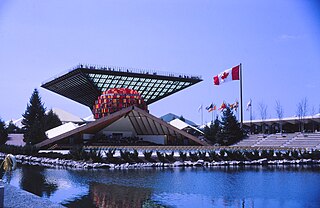Related Research Articles

A world's fair, also known as a universal exhibition or an expo, is a large international exhibition designed to showcase the achievements of nations. These exhibitions vary in character and are held in different parts of the world at a specific site for a period of time, typically between three and six months.

The 1967 International and Universal Exposition, commonly known as Expo 67, was a general exhibition from April 28 to October 27, 1967. It was a category one world's fair held in Montreal, Quebec, Canada. It is considered to be one of the most successful World's Fairs of the 20th century with the most attendees to that date and 62 nations participating. It also set the single-day attendance record for a world's fair, with 569,500 visitors on its third day.

Notre Dame Island is an artificial island in the Saint Lawrence River in Montreal, Quebec, Canada. It is immediately to the east of Saint Helen's Island and west of the Saint Lawrence Seaway and the city of Saint-Lambert on the south shore. Together with Saint Helen's Island, it makes up Parc Jean-Drapeau, which forms part of the Hochelaga Archipelago. To the southeast, the island is connected to the embankment separating the seaway and Lachine Rapids.
Mairuth Hodge Sarsfield, CQ was a Canadian activist, diplomat, journalist, researcher and television personality, as well as an accomplished broadcaster, civil servant, and best-selling author.
"A Place to Stand, a Place to Grow" (Ontari-ari-ari-o!) is the unofficial provincial anthem of the Canadian province of Ontario. It was written as the signature tune for a movie of the same name that was featured at the Expo 67 Ontario pavilion.

The Biosphere, also known as the Montreal Biosphere, is a museum dedicated to the environment in Montreal, Quebec, Canada. It is housed in the former United States pavilion constructed for Expo 67 located within the grounds of Parc Jean-Drapeau on Saint Helen's Island. The museum's geodesic dome was designed by Buckminster Fuller.

In the Labyrinth(French: Dans le labyrinthe) is a 1967 Canadian experimental film presented at the multi-screen section of the Labyrinth pavilion at Expo 67 in Montreal, Quebec, Canada. It used 35 mm and 70 mm film projected simultaneously on multiple screens and was the precursor of today's IMAX format.
Expo 67 was held in Montreal, Quebec, Canada. The opening week began at the end of April 1967. The official opening ceremonies for the 1967 International and Universal Exposition or Expo 67 occurred on Thursday, April 27 at the Place des Nations pavilion. On Friday, April 28, Expo 67's doors opened to the public and Al Carter was the first of over 310,000 visitors that day.

The Expo 67 International and Universal Exposition featured 90 pavilions representing Man and His World, on a theme derived from Terre des Hommes, written by the famous French pilot Antoine de Saint-Exupéry.

The 1986 World Exposition on Transportation and Communication, or simply Expo 86, was a World's Fair held in Vancouver, British Columbia, Canada from May 2 until October 13, 1986. The fair, the theme of which was "Transportation and Communication: World in Motion – World in Touch", coincided with Vancouver's centennial and was held on the north shore of False Creek.
Expo '67 Report was a Canadian news television series which aired on CBC Television in 1966.
Expo This Week was a Canadian news television series which aired on CBC Television in 1967.
Music Canada was a Canadian music television miniseries which aired approximately monthly on CBC Television from 1966 to 1967.
In Person is a Canadian music variety television series which aired on CBC Television from 1966 to 1968.

The Québec Pavilion was a pavilion at Expo 67 in Montreal on Notre Dame Island. It featured modern architecture and exhibited Quebec's urban and industrial growth.

The Canadiens–Maple Leafs rivalry is an ice hockey rivalry between the Montreal Canadiens and Toronto Maple Leafs, two professional ice hockey clubs in the National Hockey League (NHL). The Canadiens and Maple Leafs are the league's oldest teams, with the former established in 1909 and the latter in 1917. Both clubs compete in the Atlantic Division of the NHL's Eastern Conference.
A Place to Stand is a 1967 film produced and edited by the Canadian artist and filmmaker Christopher Chapman for the Ontario pavilion at Expo 67 in Montréal, Québec, Canada. For the film, he pioneered the concept of moving panes, of moving images, within the single context of the screen. At times there are 15 separate images moving at once. This technique, which he dubbed "multi-dynamic image technique" has since been employed in many films, notably Norman Jewison's 1968 film The Thomas Crown Affair. Mr. Jewison has credited Mr. Chapman as the creator of the edit style. The technique can also be seen more recently on television in the series 24.

The Canadian Pavilion at Expo 67 in Montreal featured an inverted pyramid structure as well as a walk through an attraction called the "People Tree." The pavilion had its highest single-day attendance on Canada Day, 1967.
The World on Stage is a Canadian variety television series which aired on CBC Television in 1967.
Through the Eyes of Tomorrow is a Canadian variety and public affairs television series for youth which aired on CBC Television from 1966 to 1969.
References
- ↑ Corcelli, John (May 2005). "Pavilion". Canadian Communications Foundation. Retrieved 7 May 2010.